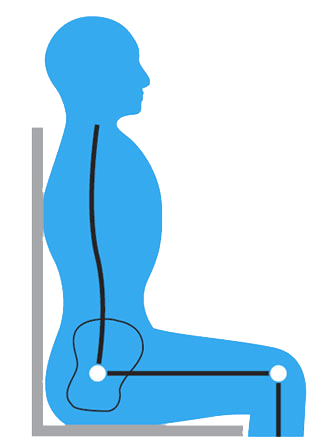
Here at Freightlink the health and wellbeing of our customers is important to us and we understand the difficulties in leading an active lifestyle when you're behind the wheel of a truck or van all day.
This month, we are proud to launch the first in a new series of articles focusing on 'your' health and wellbeing.
If you’re eating the right food, keeping fit and staying in shape, your body will be fit and strong enough to deal with the demands of being on the road. HGV driving can be stressful, but hopefully with our help and advice we can go some way to alleviating these issues and help you on your journey.
 We kick of this series with one of the most common issues for drivers, posture. As a truck driver we understand that you probably spend most of your time sitting in your cab. Sitting is a big part of your job, right? If you pull up at any truck stop and look around at other drivers getting out of their cabs, chances are you would see someone struggling from some sort of discomfort. Whether it is that first big stretch they make as they start to walk around, or even worse, walking with a hunch and have clear, visible, upper body stiffness.
We kick of this series with one of the most common issues for drivers, posture. As a truck driver we understand that you probably spend most of your time sitting in your cab. Sitting is a big part of your job, right? If you pull up at any truck stop and look around at other drivers getting out of their cabs, chances are you would see someone struggling from some sort of discomfort. Whether it is that first big stretch they make as they start to walk around, or even worse, walking with a hunch and have clear, visible, upper body stiffness.
It’s fair to say that sitting for long periods of time can be detrimental to your health. Potential blood clots, heart attacks and strokes (in extreme cases) have all been experienced by a driver at some stage in the past. With the increased sitting times, your hip flexors tighten up, and so do your hamstrings. The human body, unfortunately was not designed to sit for long periods of times, and when it does, added stress is put on the body. Truck drivers back pain unfortunately happens all too often.
Whilst the above sounds like doom and gloom, there are some simple changes you can make in order to limit or prevent the effects of back pain from truck driving.
Whether it is changing your posture or trying out some of these simple exercises, these steps only take a minute or two to perform.
1) Correcting Your Posture
When you’re sitting position starts to become uncomfortable, it starts to break the body down. Certain muscles will start to be pulled in directions that they weren’t meant to be pulled. As a result of this, you may experience chronic pain.
You need to be conscious and aware of your posture. When you enter your cab, make sure that your seat is positioned correctly, your arms are relaxed and your legs lightly touch the seat. It is extremely important that your back is straight and upright. This is key! You should not under any circumstances, feel a single element of tightness in your body. If your posture and seating position is correct, you should feel relaxed.
2) Light Stretches As You Drive
Stretches wake the body up, increase blood flow and stop you from getting stiff. When you make a stop, start by doing some quick stretches in your cab. You can do pretty much anything -
- Stretching the arms or the wrist
- Head rotations
- Head tilts from side to side
All of the mentioned above will help stretch out your ligaments and reduce the chance of longer term pain. It’s important that you do some form of stretching every time you stop, board your ferry or even in your cab in a traffic jam on the m25!
Know Your Body
Only you know your own body as well as you do. Even a short stop and walk around for a few minutes is better than nothing. You might laugh reading this, but if you’re at a truck stop do a few laps around your truck (it’s big enough, right?) with a coffee in your hand, making sure you stretch out your hamstrings (they are connected to the back). There's also plenty of decks you can cover on foot on your next ferry trip!
If you’re ahead of schedule, make a quick stop just so that you stand up. This helps to relieve the stress on your body that is slowly developing from sitting and helps increase your circulation after a long period of inactivity.
We chose this topic first as we know it’s very common within the industry, so follow these simple but effective tips and keep them in the back of your mind when you’re out on road. Doing what you can do to prevent back pain will go a long way to a healthier, happier you, and ultimately contribute to a better driving experience.
If you have any suggestions for the next installment of the Freightlink ‘Better Health’ series, get in touch. We would love to hear from you. Drive Safe!





 United Kingdom
United Kingdom Republic of Ireland
Republic of Ireland Polska
Polska România
România Republica Moldova
Republica Moldova Российская Федерация
Российская Федерация Украина
Украина Республика Беларусь
Республика Беларусь Литва
Литва Латвия
Латвия Эстония
Эстония Deutschland
Deutschland Schweiz
Schweiz Österreich
Österreich Lichtenstein
Lichtenstein Belgien
Belgien Luxemburg
Luxemburg Magyarország
Magyarország Česká republika
Česká republika Slovenská republika.
Slovenská republika. España
España Italia
Italia Bulgaria
Bulgaria








